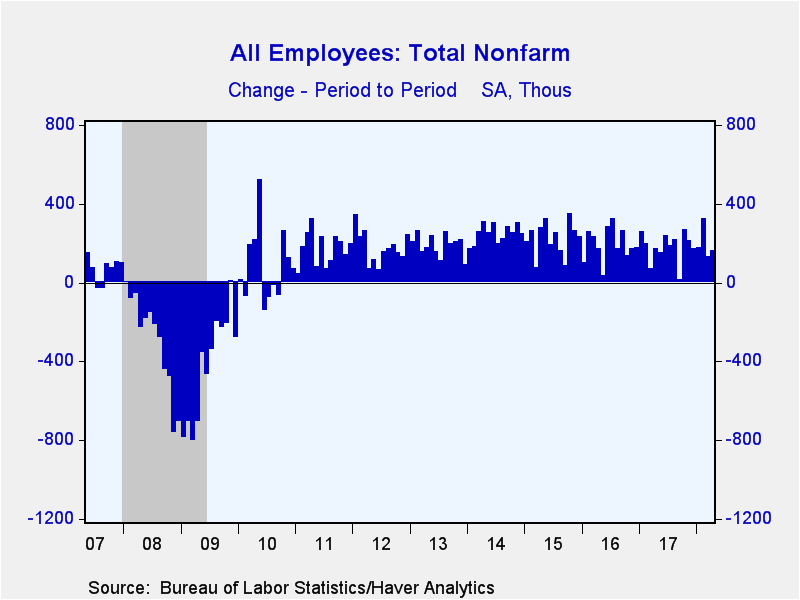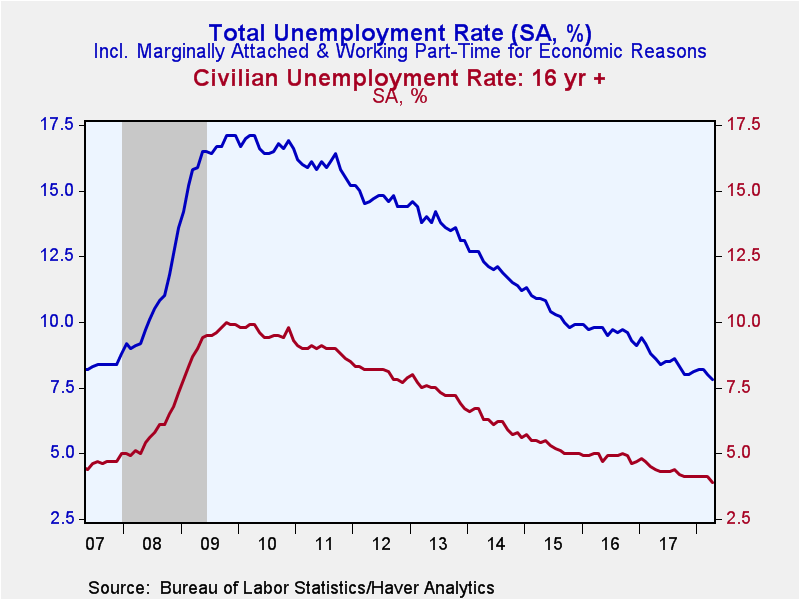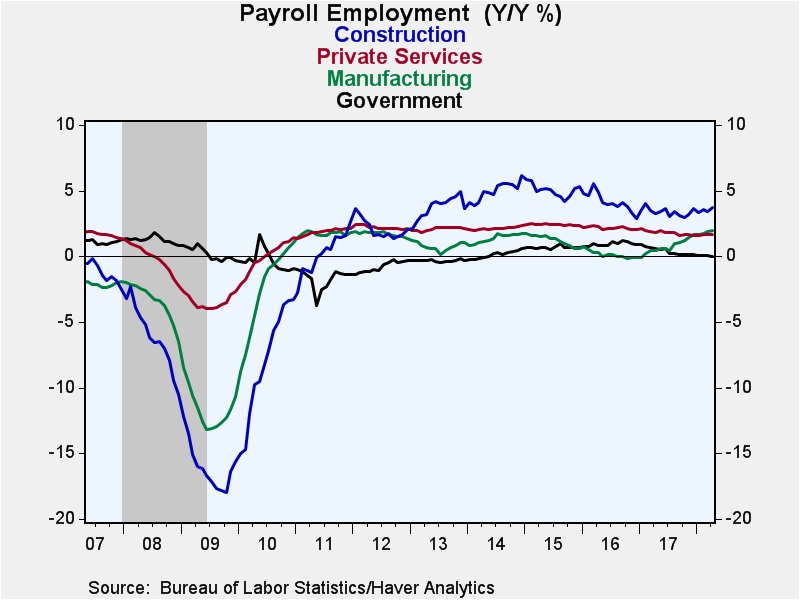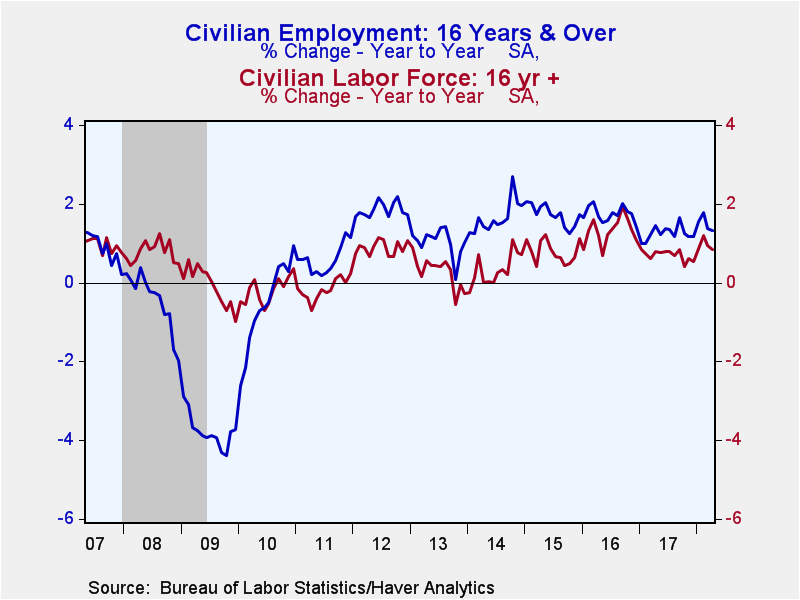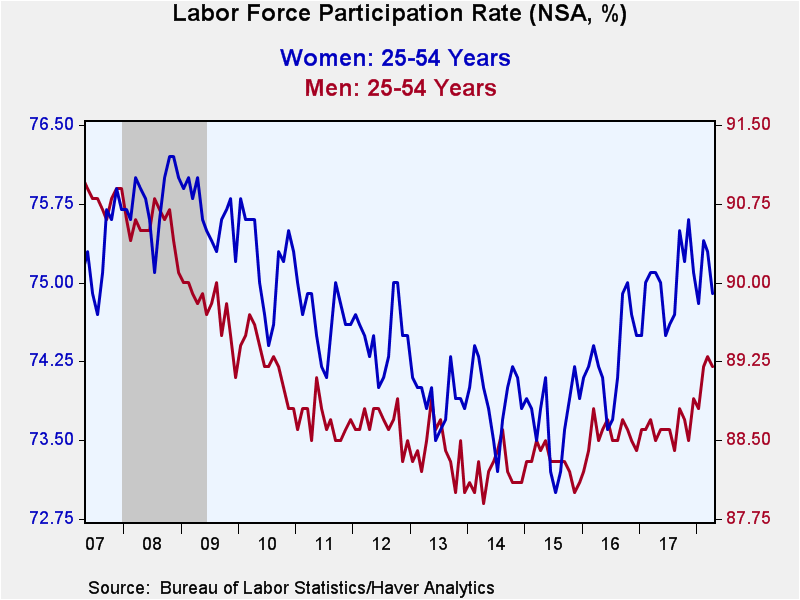 Global| May 04 2018
Global| May 04 2018U.S. Payroll Growth Remains Subdued; Wage Growth & Jobless Rate Ease
by:Tom Moeller
|in:Economy in Brief
Summary
The job market continued to lose its vibrancy during April. Nonfarm payrolls rose 164,000 (1.6% y/y) following a 135,000 March gain and a 324,000 February increase. Together, these two figures were revised up by 30,000. A 190,000 [...]
The job market continued to lose its vibrancy during April. Nonfarm payrolls rose 164,000 (1.6% y/y) following a 135,000 March gain and a 324,000 February increase. Together, these two figures were revised up by 30,000. A 190,000 increase in payrolls had been expected in the Action Economics Forecast Survey. Average hourly earnings growth eased to 0.1% (2.6% y/y) after a 0.2% rise, revised from 0.3%. A 0.2% gain had been expected.
The unemployment rate declined to 3.9% following six consecutive months at 4.1%. A dip to 4.0% had been expected. The overall unemployment rate, including the marginally-attached and those working part-time for economic reasons, declined to 7.8%, its lowest level since July 2001.
From the payroll employment survey, the 164,000 increase in jobs overall included a 24,000 increase (2.0% y/y) in factory sector employment. The monthly rise puts it on par with the average gain in 2018 and compares to a 17,000 monthly average last year. Construction sector jobs rose 17,000 (3.8%). The 26,000 monthly average increase so far this year was roughly steady with 2017. Mining sector employment gained 8,000 (9.7% y/y). The 7,800 monthly average gain through April compares to 4,900 last year.
The 119,000 job increase (1.7% y/y) in private service sector employment left the 145,000 four month average close to last year's 143,000 average gain. Jobs in professional & business services rose 54,000 (2.6 y/y) last month following a 39,000 increase. Temporary help employment rose a steady 10,300 (3.8% y/y). Education & health service sector jobs grew 31,000 (1.8% y/y) after a 24,000 increase. Jobs in the leisure & hospitality sector increased 18,000 (1.7% y/y) following an 8,000 gain. Information sector employment improved a steady 7,000 (-0.9% y/y) and financial sector employment grew 2,000 (1.5% y/y), down from a 12,000 monthly average last year. Employment in the trade, transportation & utility sector declined 7,000 (+1.1% y/y) after a 45,000 average monthly increase in the first quarter. Retail trade employment rose a reduced 1,800 (0.5% y/y).
Government sector employment declined 4,000 last month and was unchanged y/y. Local government employment improved 2,000 (0.4% y/y) following no change in April. Federal government jobs bumped 1,000 higher (-0.3% y/y), the same as in March. The number of state government jobs declined 7,000 (-1.1% y/y) after a 1,000 dip.
The length of the average workweek, held steady at an elevated 34.5 hours for the third straight month. The mining sector workweek was elevated at 45.6 hours and construction sector hours lengthened to 39.5 hours, the longest since January 2016. Financial activity hours strengthened to 37.6 while information sector hours held at a reduced 36.1. Professional & business services hours were 36.2, the longest since late 2015. Education & health services hours were 33.0, a ten year high and leisure & hospitality hours have been stable near 26.1 since the middle of 2016.
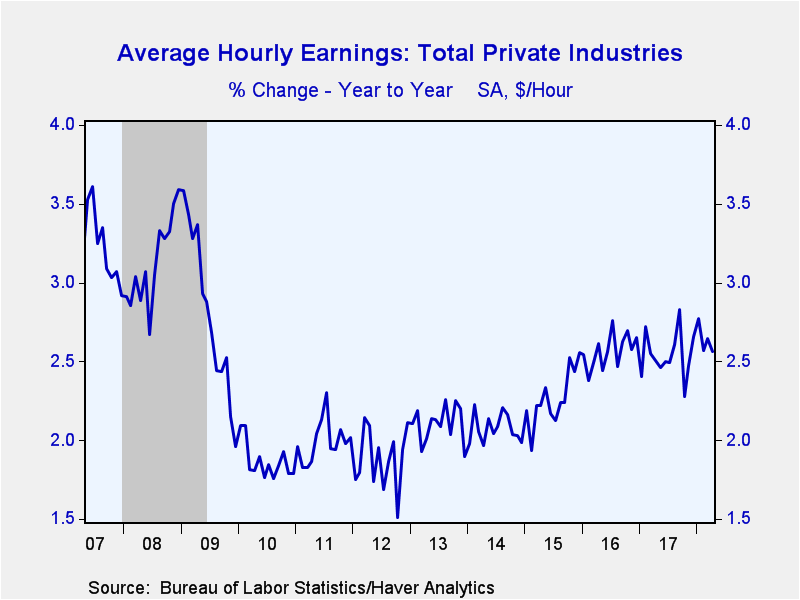 Average hourly earnings inched 0.1% higher (2.6% y/y).
Holding back the increase were declines in the financial activities (+4.0% y/y)
and the education & health services sectors (+2.3% y/y). Construction sector
earnings grew 0.6% (3.5% y/y) but factory sector earnings ticked just 0.1%
higher (1.4% y/y). Professional & business services sector earnings grew
0.3% (2.2% y/y) for the fifth month in the last six.
Average hourly earnings inched 0.1% higher (2.6% y/y).
Holding back the increase were declines in the financial activities (+4.0% y/y)
and the education & health services sectors (+2.3% y/y). Construction sector
earnings grew 0.6% (3.5% y/y) but factory sector earnings ticked just 0.1%
higher (1.4% y/y). Professional & business services sector earnings grew
0.3% (2.2% y/y) for the fifth month in the last six.
From the household sector employment survey, the decline in the unemployment rate to 3.9% reflected a 3,000 increase in employment and a 236,000 decline in the labor force. The labor force participation rate eased to 62.8%, but for those aged 25-54 it rose to 82.2%. For women of that age, it has risen to 74.9% from 73.7% during all of 2015, while for men of that age it's improved moderately to 89.2%. The average duration of unemployment fell to 23.1 weeks from 25.0 weeks during all of last year.
By educational attainment, the unemployment rate for those with less than a high school diploma ticked up to 5.9%. For high school graduates but without a degree, it was stable at 4.3%. For individuals with less than a bachelors degree the jobless rate was 3.5% and for college graduates it was 2.1%.
The teenage unemployment rate of 12.9% included a higher 15.3% jobless rate for men. For all aged 20-24, the unemployment rate was 6.7%. Individuals aged 25-54 were 3.4% unemployed and those over age 55 were 3.0% without work.
The labor market data are contained in Haver's USECON database. Detailed figures are in the EMPL and LABOR databases. The expectations figures are in the AS1REPNA database.
| Employment: (SA, M/M Change, 000s) | Apr | Mar | Feb | Apr Y/Y | 2017 | 2016 | 2015 |
|---|---|---|---|---|---|---|---|
| Payroll Employment | 164 | 135 | 324 | 1.6% | 1.6% | 1.8% | 2.1% |
| Previous Estimate | -- | 103 | 326 | -- | -- | -- | -- |
| Manufacturing | 24 | 22 | 31 | 2.0 | 0.7 | 0.1 | 1.2 |
| Construction | 17 | -10 | 67 | 3.8 | 2.4 | 4.1 | 5.0 |
| Private Service-Producing | 119 | 115 | 214 | 1.7 | 1.8 | 2.2 | 2.4 |
| Government | -4 | 0 | 3 | 0.0 | 0.4 | 0.9 | 0.7 |
| Average Weekly Hours - Private Sector | 34.5 | 34.5 | 34.5 | 34.4 | 34.4 | 34.4 | 34.5 |
| Private Sector Average Hourly Earnings (%) | 0.1 | 0.2 | 0.1 | 2.6 | 2.5 | 2.6 | 2.3 |
| Unemployment Rate (%) | 3.9 | 4.1 | 4.1 | 4.4 | 4.4 | 4.9 | 5.3 |
Tom Moeller
AuthorMore in Author Profile »Prior to joining Haver Analytics in 2000, Mr. Moeller worked as the Economist at Chancellor Capital Management from 1985 to 1999. There, he developed comprehensive economic forecasts and interpreted economic data for equity and fixed income portfolio managers. Also at Chancellor, Mr. Moeller worked as an equity analyst and was responsible for researching and rating companies in the economically sensitive automobile and housing industries for investment in Chancellor’s equity portfolio. Prior to joining Chancellor, Mr. Moeller was an Economist at Citibank from 1979 to 1984. He also analyzed pricing behavior in the metals industry for the Council on Wage and Price Stability in Washington, D.C. In 1999, Mr. Moeller received the award for most accurate forecast from the Forecasters' Club of New York. From 1990 to 1992 he was President of the New York Association for Business Economists. Mr. Moeller earned an M.B.A. in Finance from Fordham University, where he graduated in 1987. He holds a Bachelor of Arts in Economics from George Washington University.


